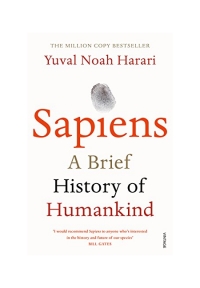

What we fail to appreciate is that our modern institutions function on exactly the same basis.

#Sapiens a brief history of humankind full#
People easily understand that ‘primitives’ cement their social order by believing in ghosts and spirits, and gathering each full moon to dance together around the campfire.
Larger numbers of strangers can cooperate successfully by believing in common myths. The maximum ‘natural’ size of a group bonded by gossip is about 150 individuals. A common belief helps us cooperate flexibly in large numbers. Fiction allows us to imagine things collectively. A truly unique feature of our language is the ability to transmit information about things that do not exist. Gossip is essential for cooperation in large numbers. Homo sapiens conquered the world thanks to our unique language. We can thereby ingest, store and communicate a prodigious amount of information about the surrounding world. We can connect a limited number of sounds and signs to produce an infinite number of sentences, each with a distinct meaning. The best guess is a random genetic mutation. This time period is referred to as the Cognitive Revolution. The first objects that can reliably called art date from this era, as does the first clear evidence for religion, commerce and social stratification. 70,000-30,000 years ago witnessed the invention of boats, oil lamps, bows and arrows, and needles. One of the oldest-known uncontested examples of art (35,000-40,000 years old) Whether Sapiens are to blame or not, no sooner had they arrived at a new location than the native population became extinct. 1-4% of the unique human DNA of modern populations in the Middle East and Europe is Neanderthal DNA. The ‘Replacement Theory’ suggests that Sapiens could not breed with other humans and killed them off either directly by force or indirectly through competition of resources. The ‘Interbreeding Theory’ suggests that Sapiens bred with other human populations and people today are the outcome of this interbreeding. 70,000 years ago, Sapiens from East Africa spread from the Arabian peninsula, and from there they quickly overran the entire Eurasian landmass. By shortening the intestinal track and decreasing their energy consumption, cooking inadvertently opened the way to the jumbo brains of Neanderthals and Sapiens. Humans spend one hour eating cooked food. Chimpanzees spend five hours a day chewing raw food. Fire allowed humans to cook, which made many more foods digestible. 300,000 years ago, humans were using fire on a daily basis. Many historical calamities, from deadly wars to ecological catastrophes, have resulted from this over-hasty jump. Having been one of the underdogs of the savannah, we are full of fears and anxieties over our position, which makes us doubly cruel and dangerous. 100,000 years ago, Homo sapiens jumped to the top of the food chain so quickly that the ecosystem did not have time to adjust. Our hands evolved to perform intricate tasks and produce sophisticated tools. Upright walking on two legs is another singular human trait. We paid for our large brains by spending more time searching for food and muscle atrophy. All humans have extraordinary large brains compared to other animals. There may be many more lost relatives of ours still waiting to be discovered.Ĭredit: Encyclopædia Britannica The Cost of Thinking Homo ergaster (Working Man) evolved in East Africa as well. Homo rudolfensis (Man from Lake Rudolf) evolved in East Africa. They lived on the Indonesian island of Flores. Homo floresiensis were dwarf humans, reaching a max height of only 3.5 feet and weighing no more than fifty-five pounds. Homo soloensis (Man from the Solo Valley) occupied the island of Java in Indonesia. Homo erectus (Upright Man) populated eastern regions of Asia and survived there for 2 million years making it the most durable human species ever. Homo neanderthalensis (Neanderthals) lived in Europe and western Asia. Homo sapiens are just one of many different species of humans that once lived. Until about 10,000 years ago, many different human species coexisted. The rise of sapiens kickstarted the Cognitive Revolution about 70,000 years ago. Homo sapiens-the species sapiens (wise) of the genus Homo (man). Prehistoric humans were insignificant animals with no more impact on their environment than gorillas, fireflies or jellyfish. 

Animals much like modern humans first appeared ~2.5 million years ago.








 0 kommentar(er)
0 kommentar(er)
